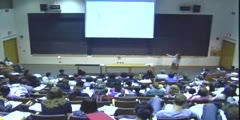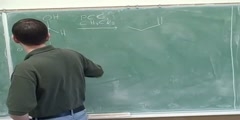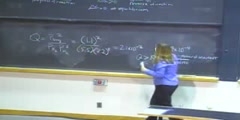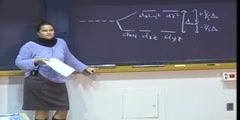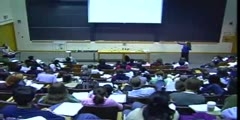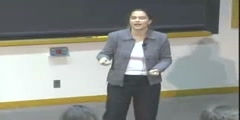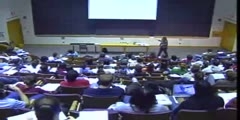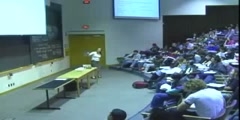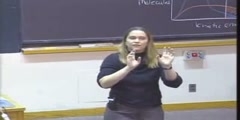Chemical Science - Oxidation Reduction (cont.) - Lecture 26
Principles of Chemical Science/n * Email this page/nVideo Lectures - Lecture 26/nTopics covered: /nOxidation/Reduction (cont.)/nInstructor: /nProf. Catherine Drennan/nTranscript - Lecture 26/nGood afternoon./nGood afternoon everybody. I am going to start this morning, or this afternoon with a question we had at the bottom of last lecture's handout./nBut we are not going to actually answer this question until the end of today's lecture./nLet's look at what the question is, and you can be thinking about it during today's lecture. All right. The question is vitamin B12, which we have already mentioned once in this course, it has a large negative redox potential./nThe standard reduction potential is large and negative./nHow does it get reduced in the body? Let's think about the problem here. As we learned last time, compounds with large negative reduction potentials are hard to reduce./nThey are easy to oxidize, which makes them good reducing agents, but they are hard to reduce. And vitamin B12 has a large negative value so it is hard to reduce./nBut in the body it needs to be reduced to be active for one particular enzyme./nIt needs to be reduced but it is hard to reduce, so what does the body do to compensate? How does this work? I am going to answer this at the end of class, but let me first tell you in the beginning of class why this is an important question./nThe proper functioning of a particular enzyme requires reduced B12 and also another B vitamin called folic acid./nAnd this particular enzyme is believed to be important in preventing heart disease and also important in preventing birth defects and also important for maintaining mental health./nThis September, Laura Philips, who is a recitation instructor, and I went to Oxford to attend a meeting on vitamin B12. And it was a very medical-based meeting./nAnd a large number of the talks were by physicians talking about treating people with B12 deficiencies that had mental illnesses./nAnd they told one story of a man who was sort of a middle-aged man who couldn't really function at work. He couldn't remember what he was supposed to be doing, and so he was having trouble. He was having trouble driving./nHe couldn't remember all the rules of the road. And of course, it seems like in England, this guy was in England, that was even more complicated./nAnd he would leave his house and couldn't remember where he lived./nHe had all these symptoms that were sort of Alzheimer's disease but he was not an older man. And it did not seem like Alzheimer's was right so eventually he ended up with this physician who diagnosed that he had a B12 deficiency./nAnd it was great for this particular individual because when they started giving him vitamin B12 in high doses he actually recovered. He got his driver's license back./nHe got his job back. And he was able to get back and forth from home without any challenges./nI think a lot of the time one cannot point to B12 as the source of any mental forgetfulness. And people do ask me. People advertise this. Like in health food stores you can buy vitamin B12 and it talks about improving one's memory and things like that./nI think that if you had a vitamin B12 deficiency you should be taking B12./nBut I think if you do not have a B12 deficiency taking excess is not going to help you do better on exams. Although, I guess they do have squirt B12, just a little extra dose squirted in the nose before the exam just to be on the safe side in case that helps./nI won't vouge for anything like that with memory and B12, but nonetheless these enzymes are important. And it is important to figure out how the B12 gets reduced so the enzyme can function. What is the enzyme?/nThe enzyme's name is methionine synthase, and it uses these two B vitamins, vitamin 12 and folic acid./nIt converts an amino acid called homocysteine to another one call methionine. And it also converts one form of the folic acid to another form of the folic acid. And, as I said, inhibition of this enzyme is believed to be involved with heart disease, it has been linked to birth defects and also anemia./nAnd perhaps a real deficiency has been linked to mental issues./nThis is a pretty important enzyme, but there are only two enzymes in humans that use vitamin B12. Birth defects in one of those enzymes can lead to this problem I talked about with buffering the blood./nAnd that can lead to death in infants if it is not corrected, if it is too severe of a problem because the blood cannot handle the change in pH. And this one is also quite important medically. At this point, I think I may have scared you that you want to know if you are getting enough B12 and folic acid in your diet./nSo I thought I would share with you where you get B12 and folic acid in your diet./nAt the end of class we will talk about how B12 is reduced. Where do you get these in your diet? Well, for vitamin B12, does anybody know, in your diet? I have heard spinach. No./nTotal cereal that is supplemented with vitamins, that is a good way to get it./nBut naturally occurring it comes in meat, red meat and other forms of meat. This is the one vitamin that vegetarians say they need to have supplemented. And it is not a huge problem because, as I said, cereal and other things./nBut in the natural diet it comes from meat. And what about folic acid?/nVegetables, yeah. Folic from foliage, so green leafy things work. Also I was at another meeting with medical doctors talking about vitamin B12 and folic acid./nThese were Norwegian physicians. They informed me of another source of folic acid that I was unaware of, which is apparently Norwegian beer./nI cannot vouge for this but that is what they told me./nAlso perhaps a better source would be leafy green vegetables. And orange juice is actually quite good. Some of you may have seen this commercial, raise your hand if you have seen this, with orange juice and it says orange juice, it is good for your heart? Have you seen that ad? That actually is probably true./nAnd that is true because you get a lot of folic acid in orange juice./nAnyway, here are some dietary suggestions for you. All right. But you actually don't have to worry too much about folic acid anymore because now it is fortified in bread. In addition to breakfast cereals, bread now has extra folic acid./nAnd this started as a campaign because if you are a woman who is pregnant you need a lot of folic acid or the baby can be born with birth defects./nNow, the problem is that often you need the folic acid before you know that you are pregnant./nYou need the folic acid from day one. And so a lot of scientists have been campaigning in Washington for a long time saying we need to put the folic acid in bread because the woman need the folic acid before they know that they are pregnant./nThis argument did not go very well, and it was years and years and years of this argument./nAnd then all of a sudden some studies came out that really linked folic acid and heart disease through the activity of this B12 dependent enzyme, and all of a sudden the climate in Washington changed and they say, oh, this may prevent heart disease./nAll right. Let's fortify bread. That is a good example of sort of science and politics where political decisions that are made about science are really based on politics and not on the science, but at this point things are looking better./nAlthough, some recent studies have shown there are still issues for some women in getting enough folic acid./nAll right. Then we need to know how it is reduced. We are going to come back to this at the end of today and look at how all the things we have been learning about oxidation-reduction apply to not only the batteries that you buy but to the reactions such as the reaction of methionine synthase, which is actually happening in your body right now./nAll right./nToday we are going to talk about, this final lecture of oxidation and reduction, adding and subtracting half cell reactions. This is listed as a topic, but I decided to remove this so it is not actually in your handout, although it is still listed as being in your handout./nYou can cross that out just for interest of time. And we are going to talk about the Nernst equation, which is one of my favorite equations, so I am looking forward to that. All right./nA couple other announcements before we get into this material./nI want to remind people there is a forum tonight. We had a great forum last week, and so I encourage you to sign up and come to these forums. Also the problem set is due this Friday, as usual. And then the next problem set is a really short problem set that will be due Wednesday./nThat problem set just covers material on Friday's class and Monday's class, so it is actually really very short. OK./nDown to some business. All right. Adding and subtracting half cell reactions./nSuppose you needed to know something about this particular equation and the standard reduction potential for the reaction of copper two with one electron going to copper plus one, but it wasn't given and you are looking in the table and it is not given./nHowever, other things related are given./nSuppose you do find in the table copper plus two with two electrons going to copper zero, copper solid, and you find copper solid going to copper plus one plus one electron./nThat information about both of those reactions is provided, so you see the relationship between these two equations. You can use the information about these to calculate a standard reduction potential for this one./nIf you add these two reactions together you get the reaction of interest./nYou get copper two and one electron going to copper one, one electron cancels and the copper solid cancels and you get the reaction of interest./nIf you can add together two reactions to get the reaction of interest, what do you do with the standard reduction potentials to get the answer for the reduction potential for this reaction? This all comes back to delta G./nMost things are related in some ways to delta G, free energy. The free energy in the standard state, delta G knot, for that new reaction that you are interested in is equal to the delta G knot for the reaction that was a reduction in the added equations minus the delta G information for the oxidation reaction./nYou notice we are doing a derivation here? All right. Then we know something about the relationship between delta G and standard reduction potentials./nWe talked about this last time that delta G knot equals minus N, which is the moles of electrons times Faraday's constant times standard reduction potential./nIf we substitute that into all of these we get this equation, and we can cancel out the Faraday's constant and solve then for the standard reduction potential for the new reaction, which is what we want./nIf we get rid of Faraday's constant it cancels out./nBring the number of moles of electrons for the new reaction down here. We get this equation which tells you about the number of moles of the reaction in the standard reduction potential for the reduction reaction, number of moles of electron, the standard reduction potential for the reaction that is in oxidation./nThat is added to the reduction to give you this new reaction./nAnd that is divided by the number of moles electrons involved in that new reaction that you are interested in. Let's use that then. If we go and we look, these were, are two reactions that we are adding together./nOne is an oxidation. One is a reduction. And we can look up what the standard reduction potentials are that are related to those two equations. The standard reduction potential, copper two to copper, copper plus one to copper./nAgain, we are looking up reduction potentials./nAnd we can find out what those are and then we can plug them in. Here is our equation again. For the reduction, we have two electrons involved in the reduction and a standard reduction potential of plus 0.340 volts./nThen we put in the information about the reaction that was written as an oxidation./nAnd so that is minus. There is one electron involved in that. And a reduction potential. Again, it is entered in as the reduction potential./nAccording to the equation this is a reduction potential of 0.522 volts. And then, in the final reaction, there is one electron involved in that. And so we put the one here and we can get out an answer of plus 0.158 volts./nAnd so now we found out a new standard reduction potential for this half reaction knowing information about other half reactions./nAnd so this would be then the copper two cooper one reduction potential. What about the cells we were talking about before, the electrochemical cells with the balanced equations?/nWell, in that case, for an electrochemical cell, the number of moles of electrons released at the anode is going to be equal to the moles taken up at the cathode, which is equal to the overall moles that get balanced out./nWhen you balance the equation, you always want to cancel out your electrons and have none left in your balance equation. Otherwise, it is not balanced. In that case, you don't use this./nIt simplifies to the equation that we talked about before where the reduction potential for the cell now, it is the cell potential, not another half potential, is equal to the reduction potential for the reaction at the cathode minus the reduction potential for the reaction at the anode./nYou use this for balanced cells and you use this for half cell reactions. And so, again, for a half cell reaction you must use this. Otherwise, it is not going to work out. You can recognize a half cell reaction because it still has electrons in it./nThat is a half cell reaction./nOK. That is just sort of a little side thing that will come in handy in finishing up the problem set and on the test. And now we can talk about one of my more favorite topics, which is the Nernst equation./nA lot of you have probably experienced the ramifications of the Nernst equation without realizing that is what you have done. I assume that pretty much everybody has had an occasion where you to use your favorite gadget and discover that the battery is no longer functioning./nA few people say yeah, maybe that has happened to me./nAnd so then you start doing things like this where you either get some kind of recharger or you go out and stockpile batteries, which then if you keep them long enough it seems like they don't work either./nAnyway, that is all the Nernst equation in action. An exhausted battery is a sign that equilibrium has been reached./nAt equilibrium the cell generates zero potential across its electrodes, so it is not working anymore./nAnd so to understand this problem, we need to think about how the composition of that cell is changing over time. This gets back to all the other things that we have talked about with chemical equilibrium./nWhat do we know about this kind of stuff?/nWhat do we know about equilibrium and components of the reaction? We know that delta G changes as the composition of the reaction changes, and we know that it changes until we reach at equilibrium delta G equals zero./nWe know that delta G at some given time, at some different reaction mixture is equal to delta G knot, the delta G at standard conditions./nPlus RT, the gas constant times temperature, times the natural log of Q./nAnd Q is what? Reaction quotient. The delta G at any particular time depends on the composition, depends on the reaction that is going on, the components of that reaction. We have seen this before./nLast time we talked about the relationship between delta G and cell potential, delta E, so we know something about that relationship./nWe know that delta G knot is equal to the number of moles of electrons times Faraday's constant times delta E knot, the change in cell potential for the reaction./nAnd also this could be applied if this was delta G to delta E./nIt holds if you are under standard conditions, delta G knot, delta E knot, or under nonstandard conditions. If we combine those things, we get the Nernst equation. If we take what we already knew about delta G from before and now plug in, instead of delta G knot, minus N Faraday's constant times delta E knot./nAnd also we are going to substitute in for delta G minus N Faraday's constant times delta E over here, and we substitute over here and we keep this part the same./nAnd then if we divide by N and Faraday's constant, we get the Nernst equation here./nThe delta E at some given point for some different reaction quotient at some different time in the cell is going to be equal to the standard cell potential under standard conditions minus RT gas constant temperature over the number of moles of electrons times Faraday's constant times the natural log of Q, the reaction quotient./nWhat the cell potential is, at some given time, depends on the reaction. Where you are in the reaction./nWhat the composition of products to reactants is at that given time. This way we can calculate how close the battery is to being dead, sort of where we are in the trajectory of things, what kind of potential we are getting at that particular given time./nLet's do an example of doing the Nernst equation./nHere is a particular reaction. We have copper plus two plus zinc solid going to zinc plus two plus copper. And we are told that the zinc ion's concentration is 0.10 molar and copper plus two is 0.0010 molar./nAnd so these are not standard conditions so we know we want to use the Nernst equation./nThe first step in doing this is we will write down the Nernst equation. The cell potential at some given time is equal to the standard cell potential minus RT over N times Faraday's constant times the natural log of Q./nWe will have step one being to find the standard cell potential, so find delta E knot./nAll right. To do this we need to look at both the reactions. We need to know the standard reduction potential for both reactions./nOne reaction involves copper plus two going to copper solid. And this reaction involves two electrons. The other reaction that is going in the forward direction is that zinc solid is going to zinc plus two plus two electrons./nWe have a reduction and an oxidation./nThis reaction would be occurring where, at the cathode or the anode? At the cathode. And so that must mean that the other one is happening at the anode./nNow we need to know the standard reduction potential for the two couples./nWe need to know the reduction potential of copper two plus to copper solid, and we need to know the potential for zinc two plus to zinc solid. And we can look those up in a table. They are up here, if you can see them./nI am actually going to write them down to a couple more significant figures./nOne is 0.340 and the other is minus 0.7628, and those are in volts. OK. We have that information. And now this is a balanced reaction. There were no extra electrons floating around./nThis is a cell./nWe are trying to find a cell potential here. We can calculate that for the particular cell in question from the standard reduction potential for the reaction at the cathode minus the standard reduction potential for the reaction at the anode./nAnd so that is going to be equal to 0.34 minus a negative 0.7628./nWhich is going to give you 1.103 volts. This is the reaction we use. And, again, we are not changing the sign because we are looking up and entering standard reduction potentials./nBut you need to know which is the reaction at the cathode and which is the reaction at the anode to put them in the right place./nAll right. We have our first thing there. Now what do we need to know? Well, we also need to know Q./nStep 2, let's find Q. What is Q going to be equal to? What is on top? Concentration of?/nYeah, zinc two plus and nothing else because it's products over reactants. But we don't include solids in our equation, so it's just zinc two plus./nAnd that is going to be then over copper two plus. Again, we are not including solids. We are not including the zinc solids. Products over reactants, and we can plug this in./nWe have 0.1 over 0.0010, and that gives us 1.0 times 10 to the 2 for Q./nStep 3, we also need to know N. How many moles of electrons are involved in this reaction? Two. N equals two. We have from a copper two plus to copper solid zinc two plus to zinc solid./nThere are two electrons evolved./nThey are not in the equation because they canceled out. This one is obvious. Sometimes they are harder and you actually really have to think about how that equation was balanced to come up with the right answer for the number of moles./nAll right./nNow we can plug all that information in to the Nernst equation./nWe are looking for what the cell potential is at a particular time, so that will be equal to the standard cell potential that we calculated minus RT./nAnd R is the gas constant, so write the gas constant out, times the temperature. And the temperature for all the problems that you are going to do in this unit is always going to be at room temperature./nTimes the natural log of Q./nAnd that is going to be over two times Faraday's constant. And I am writing all this out because we are going to talk about units in a minute. Times Faraday's constant. Now we can cancel out. We will cancel moles./nAnd we are going to cancel Kelvin./nAnd we are going to left with joules per Coulomb. Is that a good thing? What does joules per Coulomb equal? A volt, right. That will do very well because we are going to have a volt here and we are going to subtract something in volts./nThat will leave us with joules and a volt equals joules per Coulomb./nThat gives us 1.103 volts minus. This calculates out to 0.0592 volts. And, if we worked this out, this would give us a number with two significant figures after the decimal point./nAnd so that leaves us with these significant figures here. We are actually going to lose one in the subtraction anyway. And we come up with an answer of 1.044 volts./nI will mention, in terms of significant figures, this is like the nastiest problem./nYeah? Do you have a question?/nSometimes when you look at the equation there is a lot of different things going on, and you actually have to do sort of a step backwards to think what were the half reactions and what was canceled./nA lot of times it is very obvious, but some of them are a little bit longer./nThere may be one in the problem set, I don't remember, but you will know what I mean when you see it. Sometimes it will be just very obvious like that, that it will be two. Other times it is a little bit harder to see, and you sort of want to think backwards to what those half reactions were and how you would have balanced them./nAll right. In terms of significant figures, these problems are probably some of the worst in terms of significant figures./nAcid base is pretty bad, too. You notice we started with a subtraction, and in the subtraction you often lose significant figures./nThen we had a division. Then we had a log. And then we had multiplication and division and then another subtraction. The only thing I can say for these problems is that it helps to really write out every step and to put a line under where your significant figure is after each calculation to make sure that you aren't getting the wrong significant figures at the end./nYou cannot, in this case, go back and say how many significant figures did I have in the information that was given to me? That is how many I have at the end./nThat is not going to work for you. These are a little bit tricky. A lot of the time you will have a break because there won't be many significant figures in this answer. And so when you do the subtraction you kind of compensate./nSometimes it doesn't matter how many you really have here because you are going to lose them in that subtraction step anyway, but just to warn you there is a lot of significant figure stuff./nThis actually would be a great significant problem if that all you were testing because you have to do every kind of significant figure situation in this one problem, but I am going to make your life slightly easier./nWhat I am going to do is do some of the steps for you./nIf we talk about constants for a minute, we are always going to be at room temperature in this unit because that is just where we are. It is going to make it harder to anything else. Unless specified, assume room temperature./nIf you do that you will find that this is always going to be the same number. You have the gas constant, the temperature and Faraday's constant, and so there is one number that that is equal to./nAnd so you can use this number./nOr, if you prefer to use log base 10 rather than natural log, you can take this number and multiply it by the conversation factor and you have sort of another constant which you can use in the problem./nAnd, on the test, I will actually give the equations in this format to you on your sheet./nAnd so you can pick one of these. If there is room I will give both. Otherwise, I will just give one. But it is the same type of problem./nYou just have to pay attention to which log to use. And I will make sure that the number of significant figures here is not limiting in the problem, so you don't have to worry about that. I highly recommend that if I provide these two you, save those extra steps of multiplying things out./nIt will save you some time and maybe a little bit of significant figure headache./nThose will be available just to simplify these problems. I am sure that you can all multiply RT over Faraday's constants, so I am just going to provide that for you and not require you to do it on the test./nWhat happens at equilibrium then? At equilibrium what does Q equal? Q equals K at equilibrium, right./nWhat about delta G? What does delta G equal at equilibrium? Zero. Do you see where we are going with this? If you have the handout you can look ahead./nWe know from before that delta G equals delta G knot plus RT natural log of Q./nWe also know that delta G knot equals minus RT natural log of K, because at equilibrium delta G is zero so we drop that out and add equilibrium./nQ equals K. We have seen this expression before so we know that. We also know the relationship between delta G and cell potential. We know that delta G knot equals minus N, the number of moles of electrons./nFaraday's constant times the standard cell potential./nNow we can rearrange these and relate the equilibrium constant to cell potential. Combining we get this, so we just set those two equal to each other and we can solve for K, or at least natural log of K in terms of cell potential./nAnd so you can calculate the equilibrium constant from cell potentials./nAnd, of course, this is important because if you want your cell to be producing some kind of current creating energy or if you want to apply something to get a non-spontaneous reaction to go, you care about what the composition of the reaction is, you care about the equilibrium constant and you care about these relationships./nIf you know about K, you can also think about if the reaction is really favorable in one direction or in the other direction at equilibrium do you have a lot more products or a lot more reactants, some of the same questions we have talked about before./nSee how all these units are kind of fitting together and how I told you that everything that you learned you have to remember because it is going to come back? It's back again. We are back to thinking about equilibrium constants./nThis half semester of the course is very, very connected./nYou cannot get away from any of the material, which is kind of good because on the exam it is kind of all related, so doing the next unit is reviewing the unit that you already did. All right. Let's look at an example of an oxidation-reduction reaction and talk about what the equilibrium constant is again at room temperature./nThis is going to involve two half reactions./nWe have a reaction with zinc in the forward direction, I mean with lead plus two going to lead solid. Lead plus two electrons going to lead solid. We also have zinc solid going to zinc plus two and then two electrons./nThose are the two half reactions involved in this cell reaction. Now, we are interested in K./nWe are interested in the magnitude of K. We want to think about if K is big. Is K greater than one for this reaction? We can do the math and calculate, knowing something about the cell potentials, or we can just think about whether this reaction would be favorable before doing the math./nIf you think about what is happening in the forward reaction, what is happening? Well, what is happening is that zinc is reducing lead plus two./nLead plus two is being reduced to lead solid and zinc is being oxidized./nIt is acting as a reducing agent. And in the backward reaction what is happening? Well, in the backward reaction we have lead solid reducing zinc plus two to zinc solid. If we think about are there going to be more products or reactants, we are really thinking about which of these two things is a better reducing agent./nIf zinc is a better reducing agent than lead it will favor the forward direction and we will have a K greater than one./nIs it a better reducing agent? We talked last time about how to figure this out, and we talked last time about the fact that things with positive numbers up here, the oxidized species of this is strongly oxidizing./nAnd at the bottom with these negative numbers, the reduced form is strongly reducing./nWe can look at where things are. There are numbers, there are standard reduction potentials, and figure out which one is a better reducing agent. If we look those up, we know the zinc couple. We just talked about that one, actually, minus 0.7628./nAnd we can look up the standard reduction potential of lead, and it is also negative but it is a smaller negative number minus 0.1263./nThis is a big negative number. Is it going to be a good reducing agent? What do we know about how difficult it is to add electrons to this? Is it hard to add electrons to this? Yeah./nIt is hard to reduce. That makes it easier to oxidize. Does that make it a good reducing agent? Yeah, it does./nBecause a reducing agent gets oxidized itself. It reduces other things. This would be a good reducing agent./nWell, what about this? Is it as good? No, it is not as good. It is probably not bad, but it is not as good a reducing agent. It would be a little easier to reduce than zinc, a little harder to oxidize, so it is not as good a reducing agent because it is a more positive number than this one./nThis is the bigger negative number so this is the better reducing agent./nIf that is the better reducing agent then the equilibrium should lie to the right. There should be more products than reactants at equilibrium because in the forward direction zinc is acting as the reducing agent./nAnd it is a better reducing agent so it should drive the equilibrium such that there are more products than reactants. And so K should be greater than one./nAnd we can actually do the math and prove that this is true./nThis is very much like when we talked in acids and bases about equilibrium and K values and how if something was a stronger acid one way then a stronger acid in the backward reaction you could predict what K would be or you could do the math./nIt is the same principle here. If we go through the math, we can plug in the standard reduction potential for the lead couple and the standard reduction potential for the zinc couple and get an answer for the cell potential./nWhat is N for this? This is also a fairly simple one? Two./nWe know N is two. And then we can plug into our equation. That is all we really needed to know to do this one. We needed to know the standard potential for the reaction, which we calculated, Faraday's constant, we need to N and RT./nAnd so we can put those in./nAnd I will also provide this with the math worked out for Faraday's constant and R and T. And so we can plug that in and put in our two and put in the number of volts, the standard cell potential that we calculated just before and go back and calculate for K./nAnd so K is 21.5. That is definitely bigger than one./nThat is a very big number. Sorry, log of K and K turns out to be a very, very big number. And so the forward reaction is definitely favored, which is what we assumed thinking about which was a better reducing agent./nIt said that the forward reaction should be favored, that K should be greater than one. And when you do the math you find that K is, in fact, greater than one. It is favored in that direction. More products than reactants at equilibrium./nIn the last couple of minutes then I want to go back to biological systems and show you that the same equations apply./nAll the same principles apply that you just learned to a biological system. Answering the question of how B12 is reduced in the body./nB12 is reduced in the body by a protein called flavodoxin, and this contains another B vitamin, a flavin B vitamin./nIf we look at the standard cell potentials, the reduction potentials for these reactions, the reduction potential E knot for vitamin B12 is minus 0.526 volts. That is a very low number for a biological system./nThat is one of the lowest standard reduction potentials that is known./nFlavodoxin is minus 0.23 volts. Let's think about this reaction and whether it is favorable or not. B12 then is a better reducing agent than flavodoxin. It has a more negative number./nAs we just saw in the last example that makes it a better reducing agent./nIt is hard to reduce B12, easier to oxidize. Flavodoxin has a more positive number. Just like we saw in the last one, it is not as good a reducing agent. If this reaction occurred spontaneously, B12 should be reducing flavodoxin, not the other way around./nWe just worked an example where we saw there was one thing that was a really good reducing agent and another wasn't as good./nAnd we had an enormous K, so it was very much favored in the other direction./nThis should not be occurring. It doesn't seem possible that this is occurring, yet it is. Is the reduction spontaneous? No, it wouldn't be. Let's actually calculate the numbers and see how bad it is./nAgain, you can use this exact same equation. Instead of calling things cathodes and anodes, you can just consider it in terms of the reduction and the oxidation./nAnd we can plug in the values. What is being reduced is B12./nWhat is being oxidized is flavodoxin in the body. We can put in the numbers minus 0.526 volts. And then it is minus a negative number of minus 0.23 volts. And we get out that the cell potential is minus 0.296 volts./nThat is not going to be spontaneous./nIt is a negative number for delta E of the cell, which is going to mean what about delta G? It is going to be positive. No, it is definitely not spontaneous. And then we can continue to go on and plug in these numbers and calculate what delta G knot would be./nBy this equation, that we have seen many times today, it is a one electron reduction, so one electron is involved./nWe plug in Faraday's constant and we plug in the cell potential, and we get plus 28.6 kilojoules per mole./nThat is a very positive number. It is a pretty big number for delta G. So how does this reaction go? Why don't we all have heart disease, magaloblastic anemia, problems finding our way home?/nWhat happens? Well, the answer is that the body has to apply energy to get the reaction to go./nIn this case, the energy comes in the form of a molecule called s-adenosylmethionine. And the cleavage of s-adenosylmethionine generates the delta G for that is minus 37.6 kilojoules per mole, so it is very favorable./nAnd it is more favorable than this reaction is unfavorable./nWhen you put those things together it goes. What do you call it when you have a cell in which an unfavorable reaction is driven by applying energy? What was that called that we talked about last time? Yeah, electrolytic cell./nThe body just does the same thing that you would to drive any non-spontaneous reaction./nIt comes up with an energy source, couples the reaction and then the reaction goes. Again, same principles that apply.
Channels: Chemistry (General)
Uploaded by: mitlectures ( Send Message ) on 16-04-2009.
Duration: 48m 10s
